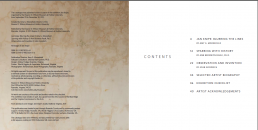Jan Knipe: Blurring the Lines Introductory Essay
Jan Knipe. 2011. Perfect bound book. Full color printing. 2012 ADDY Silver Award.
Jan Knipe transforms sheets of paper into palimpsests that selectively record her immediate environs. Drawing is a complex language. Knipe raises the bar for the discipline of drawing by her preoccupation with the margins between abstraction and the conventions of the image. For instance, in “Quarry Rocks” (1999), rocky protrusions transform into calligraphic lines; in “Tower of Babel” (2010), piles of teabags mutate into foothills. Her experimentation with the divide between the contrasting modes of representation as a point of interest and also as a method of departure characterizes her work.
Historically, the act of drawing was considered a means to an end, a method for the artist to render a thought process on a temporal surface, and as a reference for the desired finished structure, whether that was a painting, sculpture, or architectural construction. Now drawing is a respected art form in itself. Curator Bernice Rose once commented that contemporary drawing has now risen in equal footing with painting and sculpture.“….drawing has become one of the elements of a new language, and that operates in a variety of guises, conservative as well as revolutionary.” 1 Knipe’s dedication to the medium as an object and as an activity is laudable. She has been creating drawings for over thirty years, working in mixed chalks, pastel, charcoal, Conté crayon, oil paint, and pencil; oftentimes, making her own pastels and has contained her palette to primarily muted monochromatic hues. Through her facile and expressive handling of her rendering tools, she transforms perceptions of her external environment into translations that hover between the real and the abstract. She has footholds in both realms and delights in blurring the lines between them. In “Ashtabula” (2011), the surface is acutely active through a trail of pastel and Conté crayon that traces her progression over the paper. Her gestures mirror automatic writing; the forms distantly echo the landscape. Marks coalesce into images that appear and retreat through hazy lines that are worked so heavily that the implied forms appear to be embedded into the fibers of the paper.
Other works exhibit Knipe’s willingness to toss risk into the pot. In her large drawing “Roanoke”(2011), the surface of the paper is so worked, one gets the impression that she has enjoyed the challenge of taxing the sheet to the pinnacle of its makeup. Hovering on the precipice of disaster, the result is simply gorgeous. The composition appears to pulsate palpably with tremendous implied depth and luminosity. In drawing, artists have a unique handwriting. Curator and author Ruth Fine once wrote, “As in the case of ‘drawing’ and ‘realism,’ the meaning of ‘finish’ has become blurred over time… These varied notions of completeness and refinement not only reflect aesthetic interests and intentions, but also personal temperament.” 2 Often beginning in the center of the sheet and radiating out, Knipe’s compositions imply a bifurcated impression as in “Sink Hole” (2011), in which she blends two distinctive views into one. The image is compounded with her “handwriting.” She renders the landscape in a lateral band from left to right, in dark to light tones, and then finally, she implies airiness by using the bare sheet as a hue. The exposed paper conveys as much information as her gestural marks.
In the works on view in this exhibition, Knipe’s love of drawing and her gifts as a raconteur are evident. Her investigation of the boundaries of the medium builds, sheet by sheet, across the museum terrain, forming its own narrative, and emphasizing drawing’s transformative qualities.
1 Rose, Bernice. “Allegories of Moderism: Contemporary Drawings.” (The Museum of Modern Art) 1992. 10.
2 Fine, Ruth “Reflections and Shadows: Realism and Its Discontents, Contemporary American Realist Drawings: The Jalene And Richard Davidson Collection at The Art Institute of Chicago.” (The Art Institute of Chicago) 1999. 7.
Amy G. Moorefield
Director and Chief Curator
Eleanor D. Wilson Museum at Hollins University


